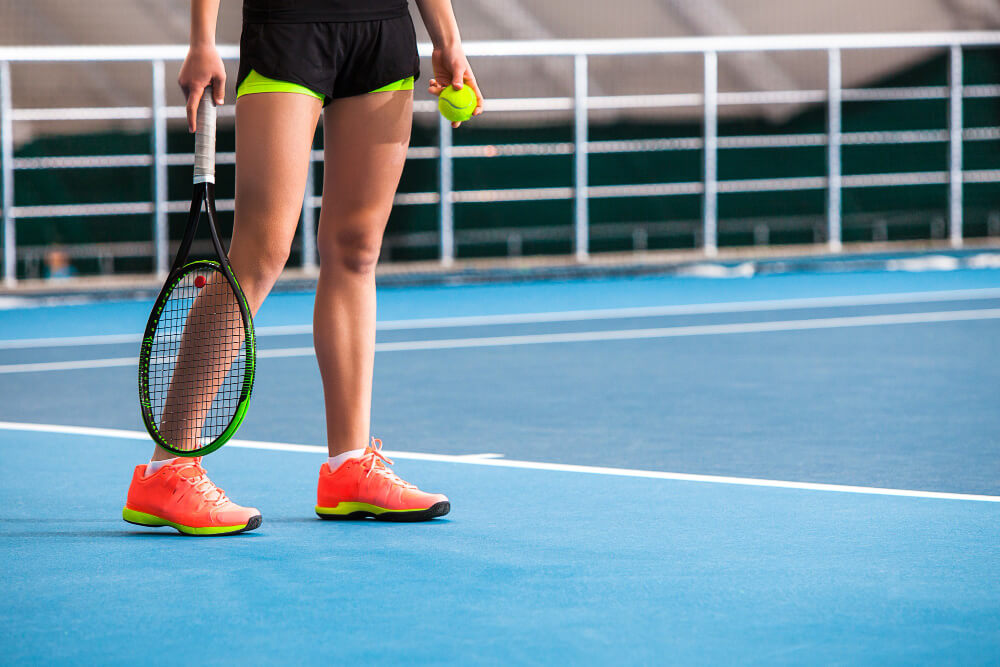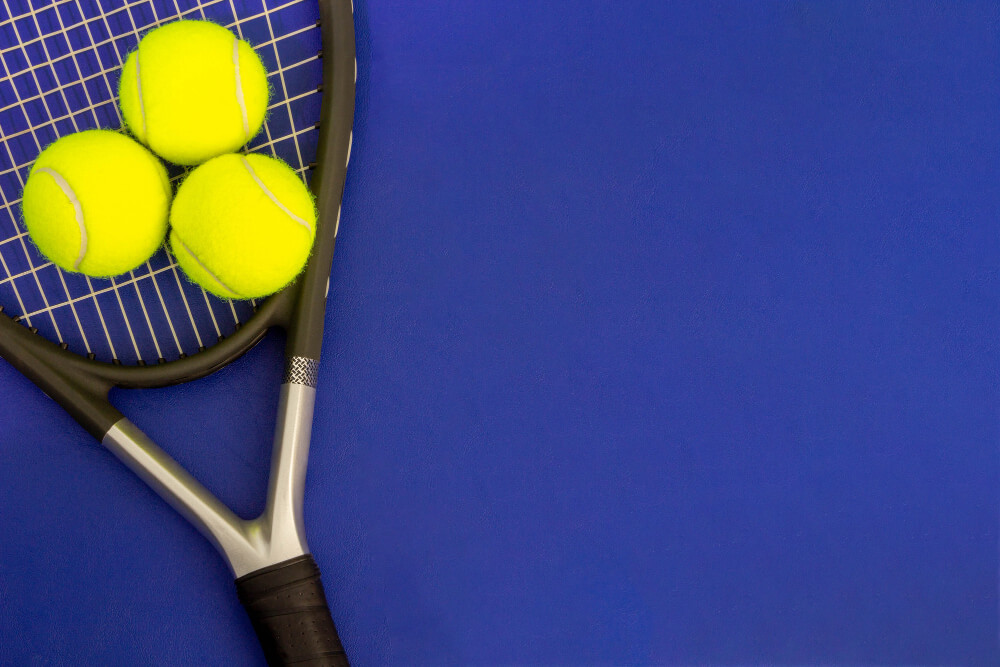Regripping a tennis racket is a simple process that can help improve your grip and control on the court. It is important to regrip your racket periodically, as the grip tends to wear down over time and can become slippery or uncomfortable to hold. In this article, we will walk you through the steps of how to regrip a tennis racket.
How to Replace a Grip on a Tennis Racket?
To begin, remove the old grip from the handle of your racket. You can do this by carefully cutting the grip with a pair of scissors, being sure not to damage the handle. Once the grip has been removed, clean the handle of your racket with the solvent or cleaning agent to remove any dirt or residue.
Next, take the grip tape and wrap it around the handle of your racket, starting at the base and working your way up. Make sure to overlap the tape as you go, and leave a little bit of excess at the top. You may want to use your fingers or a tool like a ruler to smooth out any bumps or creases in the tape.
Now it’s time to apply the new grip.
To apply a grip on a tennis racket, you will need to follow these steps:
- Gather the necessary materials: a new grip, grip tape, scissors, and a solvent or cleaning agent. You may also want to have a towel or cloth on hand to wipe down the handle of your racket.
- Remove the old grip from the handle of your racket. You can do this by carefully cutting the grip with a pair of scissors, being sure not to damage the handle. Once the grip has been removed, clean the handle of your racket with the solvent or cleaning agent to remove any dirt or residue.
- Take the grip tape and wrap it around the handle of your racket, starting at the base and working your way up. Make sure to overlap the tape as you go, and leave a little bit of excess at the top. You may want to use your fingers or a tool like a ruler to smooth out any bumps or creases in the tape.
- Apply the new grip by sliding it onto the handle of your racket, making sure that it is centered. You may want to use a little bit of the solvent to help the grip slide on more easily.
- Secure the grip in place by using the excess grip tape at the top. You can do this by carefully wrapping the tape around the top of the grip, or by using a small piece of the tape to cover the end.
- Use the scissors to trim any excess grip tape or grip that may be sticking out.
Remember to take your time and be careful when applying the grip, as it is important to get a good, secure grip. With a little bit of practice and patience, you’ll be able to apply a grip to your racket like a pro.
Do you put overgrip over the original grip?
Many players prefer to add an overgrip to their original grip to increase comfort and provide additional cushioning.
Overgrip is a thin layer of synthetic material that goes over the original grip on your tennis racket, providing extra cushioning and a more comfortable feel as you play.
When choosing an overgrip, consider factors like sweat absorption levels and texture. Higher absorbency will help keep your hands dryer during long matches while textured grips offer better grip in wet conditions and when there is a lot of sweat present.
Getting the right combination of features will help you get the most out of your Best Tennis Rackets.

How do you rewrap a tennis racquet?
There are a few key steps to rewrapping a tennis racquet, including removing the old grip and cleaning the handle, wrapping the grip tape around the handle, and applying the new grip.
- First, you will need to remove any existing grip from your tennis racquet by carefully cutting it with scissors, being sure not to damage the handle. Next, use a solvent or cleaning agent to thoroughly clean the handle of your racket.
- Once you have prepared your racquet for rewrapping, you can begin wrapping the grip tape around its handle. Start at the base of your racket and wrap upward, making sure to overlap as you go and leaving a little bit of excess at the top.
- Finally, you can apply the new grip by simply sliding it onto your racquet’s handle, making sure that it is centered and that there are no bumps or creases in the tape. Once the grip is in place, use scissors to trim any excess tape or grip that may be sticking out.
To ensure a secure and long-lasting rewrap on your tennis racquet, be sure to take your time and follow all of these steps carefully.
When should I Regrip my tennis racket?
There is no set time frame for when you should regrip your tennis racket, as the frequency with which you will need to rewrap your racquet will depend on a number of factors, including how often you play and the amount of sweat and other moisture that comes in contact with your grip.
However, if you notice that your grip is becoming worn out or losing its tackiness, then it may be time to consider regripping your racket. Other signs that indicate it may be time to regrip include fading or cracking of the material, excess wear on the edges of the grip tape, or unraveling at the top of the grip.
If you are unsure about whether your tennis racquet needs a new grip, it is best to consult a coach or professional racquet technician who can assess the condition of your grip and provide guidance on when you should regrip. With regular care and maintenance, however, many tennis players can go several or even years before needing to rewrap their racquets.
Is overgrip the same as grip tape?
No, overgrip and grip tape are not the same. While both are used to provide a more secure and comfortable grip on your tennis racquet, they have slightly different purposes and functions.
Grip tape – is a layer of fabric or plastic that is wrapped around the handle of your racquet to help you keep a firm hold on it during play.
Overgrip – on the other hand, typically goes over the existing grip on your racquet in order to increase comfort, absorb moisture, and add an extra layer of security.
If you are looking for a way to improve the feel and performance of your tennis racket, then investing in some quality overgrip may be the right choice for you. However, it is important to choose the right type of overgrip for your particular needs, as different materials and features will provide different benefits.
Whether you are a beginner just starting out with tennis or an experienced player looking to your game, choosing the right overgrip can help you maximize the performance of your racquet and take your game to the next level. So be sure to do your research, try out a few different options, and find the grip that works best for you!
Do all pros use overgrips?
There is no set rule or requirement that all pros use overgrips, and there are a variety of reasons why one player may opt for an overgrip while another does not.
For beginners and casual players, the decision to use an overgrip may be driven by comfort, convenience, or simply personal preference (click here to see the best beginner’s tennis rackets).
However, for more advanced players or those competing at the professional level, using an overgrip can have other benefits as well.
Some players may choose to use an overgrip in order to gain an extra edge on their opponents by choosing grips that provide additional grip traction or absorb moisture better. Additionally, many pros will use different types of grips depending on the surface they are playing on, as well as the weather conditions and environmental factors that may affect their game.
Overall, the choice to use an overgrip is a personal one, and whether it is right for you will depend on your individual needs, preferences, and playing style. However, by doing your research, trying out a few different options, and consulting with professional tennis coaches or racquet technicians, you can find the best overgrip for your particular needs.
Can I Regrip my own tennis racket?
If you are looking to save some money on regripping your tennis racket, then it may be possible for you to do it yourself. However, it is important to consider a few factors before attempting to rewrap your own racquet.
First and foremost, if you have never regripped a tennis racket before, then it is best to seek the guidance of a professional in order to ensure that your work is done correctly and safely. Additionally, beginners may want to start out with a simpler grip type or surface material that is easier to work with and less likely to cause damage while wrapping.
Overall, regripping your own tennis racquet can be a great way to save some money and learn more about the equipment you use in your game.
However, it is important to weigh the pros and cons of this decision carefully before attempting to do so yourself. So if you are new to regripping or unsure about your ability to do it safely and correctly, then it may be best to seek out the help of a professional instead.
If you are looking for an affordable and convenient way to improve the feel and performance of your tennis racket, then consider using an overgrip.

How much does it cost to rewrap a tennis racket?
On average, most overgrips tend to cost between $5 and $10 each, though there are also more expensive options available that may provide additional features or benefits. Additionally, some retailers will offer special promotions or discounts on their products if you buy in bulk or order online.
The cost of rewrapping a tennis racket can vary depending on various factors, such as the type of overgrip you choose, where you purchase it from, and the skill level required to do the work yourself.
As for whether it is possible to regrip your own racquet, this depends largely on your level of experience and skill with doing so. While many players claim that they have successfully rewrapped their own racquets, it is always important to proceed with caution and take the necessary steps to ensure your safety and avoid causing any damage to your equipment.
Can you put 2 overgrips on a racquet?
It is possible to put 2 overgrips on a racquet, though this may not always be the ideal solution.
If you are looking for additional durability or sweat absorption, then it may make sense to use an extra overgrip on top of your original one. However, there may also be times when using too many overgrips can actually have a negative impact on your game by changing the weight distribution or balance of your racquet.
Ultimately, if you are considering double-wrapping your racket, it is best to consult with a professional tennis coach or technician in order to ensure that this decision will be right for you and your playing style. Additionally, you should always purchase high-quality overgrips from reputable retailers to ensure that they will be durable and long-lasting.

How long after Regrip can you play?
There is no definite answer to this question, as the length of time you need to wait before using your racquet again will depend on a number of factors.
For example, depending on how much sweat or residue was left behind from the previous regripping process, it may be necessary to allow your racket some time to dry out and air out first. Additionally, if you used a particularly strong grip during the regripping process, then you may want to give yourself some extra time for any possible irritation or swelling from the adhesive to subside.
Ultimately, only by speaking with your local tennis coach or technician can you determine exactly when it is safe for you to begin using your racquet again after rewrapping it. However, in general, most experts recommend waiting at least a few hours before hitting the courts again after regripping your racket.
What can I use instead of grip solution?
There are a number of different alternatives that you can use instead of a grip solution when rewrapping your tennis racket.
For example, if you need additional durability or sweat absorption for your racquet, then you may want to consider using an extra overgrip in place of the standard one. Additionally, some players prefer to use tape or other adhesives like athletic tapes, wrist bands, and power grips to wrap their rackets.
Ultimately, the best way to determine which alternative products will work best for your needs is by speaking with a professional tennis coach or technician who can help guide you toward the right choice for your equipment and playing style.
However, in general, it is important to be aware that using alternative products may impact the feel, balance, and weight of your tennis racquet. Therefore, it is always best to do your research and consult with an expert before making any final decisions.
How long does it take for grip solvent to dry?
The drying time for grip solvent can vary depending on the specific product you are using and the ambient temperature and humidity. The length of time it takes for the grip solvent to dry will depend on a number of different factors.
For example, some products may take longer to dry than others, so it is important to carefully read the manufacturer’s instructions and ensure that you allow enough time for your equipment to fully air out before using it again.
Additionally, some solvents may require additional drying time due to their relative thickness or strength compared to other options.
Finally, the size and shape of your racquet can impact how quickly the solvents are able to dry. For example, if you have a larger head or wider string bed area, then you may need more drying time compared to someone who has a smaller head or a more compact string bed.
In general, if you are concerned about the drying time of your grip solvent, it is best to consult with a professional tennis coach or technician for advice on how long you should wait before using your racquet again. However, in most cases, grip solvents will typically dry within a few hours after application.
Can you pour grip solvent down the drain?
It is generally not recommended to pour grip solvent down the drain, as it can be harmful to the environment and to the plumbing system. Grip solvents typically contain chemicals that can be harmful if they enter the water supply or the soil.
Some less concentrated grip solvents may be safe to pour directly into a sink or toilet without causing any damage. However, more potent solvents may contain additives that are toxic or hazardous, so they should never be poured down the drain under any circumstances.
In general, if you are unsure about the safety of your particular grip solvent, it is always best to consult with a professional tennis coach or technician for advice on how to dispose of it properly. They will be able to assess your particular situation and make recommendations based on your specific needs.
Can you reuse grip solvent?
There are a number of factors that will determine whether or not grip solvents can be reused.
Some grip solvents may only be good for one use, while others may be durable enough to last for several applications. The specific formulation and concentration of the grip solvent will also impact its longevity and effectiveness in terms of reusing it multiple times.
Therefore, in order to determine whether or not your grip solvent can be reused, it is best to consult with a professional tennis coach or technician who can help assess the quality and durability of your particular product.
If they advise you against reusing any portion of your grip solvent, then it is important to follow their recommendations to avoid causing damage or injury to yourself or others. However, if they recommend that you can safely reuse your grip solvent, then you can proceed with confidence knowing that it is still effective and safe to use.
Overall, if you are careful to properly store and maintain the quality of your grip solvents, then there is a good chance that they will be reusable for multiple applications. However, it is always best to consult with an expert before making any final decisions about whether or not your grip solvents can be reused again.





